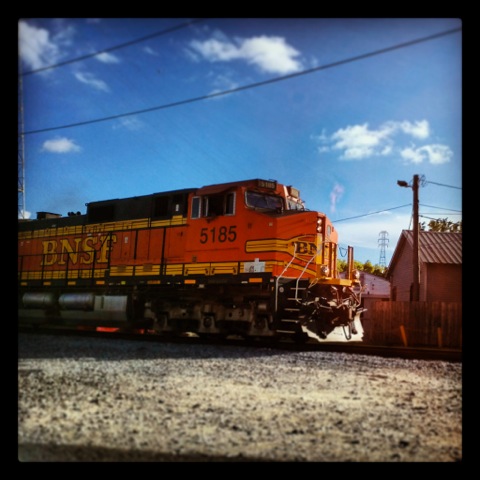
New Orleans freight train (photo by Glen Abbott)
This morning I awoke to the sounds of crystal glasses clanging against one another inside my china cabinet. It’s a common occurrence caused by the vibrations of trains rolling just about 60 feet from my front door through my Old Metairie neighborhood.
A train rolls by about every 30 minutes. With some as long as 150 to 200 cars, they can take about 10 minutes to rumble past my house. On holidays we see fewer, but the days before and after are a near constant stream of cars riding down the rails.
My street is divided by the train tracks. I live on the south side of the tracks, better known as “the Airline side” — as opposed to “the Metairie side.” When I first moved to the neighborhood, delivery drivers could never find my house. I got quite a few free Domino’s pizzas in those days before GPS, when they didn’t make their 30-minute guarantee looking for my address.
Even when you Google my address today, you get a picture of a vacant lot down the street on the corner. But that’s a story for another time.
Loose nails and lost sleep
About once or twice a year, my family would make the rounds of the interior and exterior of the house looking for nails that had wiggled loose from the vibrations so we could pound them back into place. The kids learned to sleep through all the tremors rattling the windows and china. It became just another background noise.
Today, I have a virtually sound-proof house, but that doesn’t help with the “trainquakes,” which still shake china and glassware off the shelves. It scares the heck out of visitors to the house when they can feel the train but not hear it.
Last summer, one night around 9 o’clock, the engineer began sitting on the horn as a train rolled through our neighborhood. They just don’t blow like that anymore since the installation of lights and gates at each crossing. My neighbors and I ran to our respective front porches just in time to see a train come to a screeching halt at a crossing a block and a half away. In the bright light streaming from the engine we could see a car straddling the tracks, where it had run off the crossing. The driver and his passenger were trying to push the car off the tracks even as the train was bearing down on them.
That summer we also saw teenagers jump onto the moving train at Metairie Playground, and ride it through the neighborhood to LaBarre Road, where they would jump off and walk half a block to a neighborhood eatery for a snack.
Volatile cargo
I had pretty much forgotten about the time back in the ’80s, when a train car jumped the tracks about a block away. Only some very large trees standing nearby kept it from sliding into our street. It was a tanker car and, fortunately, all but empty, with just the residue of anhydrous ammonia. Had it been full, we might have suffered a fate similar to Lac-Megantic, Quebec. A train there was carrying crude oil when it recently went off the rails, exploded into flames and took out their entire downtown area.
The Federal Railroad Administration says that in 2012, 663 rail cars carrying hazardous materials derailed or were damaged in the United States. And Louisiana is among several states that have projects already completed or in the works to accept shipments of crude oil like the one in Quebec.
Crude oil isn’t even the most hazardous material transported by rail. Every day, numerous rail cars carrying chlorine, phosphoric acid, propane, anhydrous ammonia, ethanol and other chemicals I can’t pronounce, much less spell, roll the rails less than 60 feet from my front door. Some of those cars are substandard tankers … the Exxon Valdez of the rails.
Derailment plans
These tracks, carrying 85 percent of all rail traffic in and out of New Orleans, originally were put in to facilitate moving military equipment during World War II. In fact, on occasion, we still see sand-camouflaged military equipment moving westward, to be shipped to far countries. The tracks were to be removed after the war.
A few months after I moved into my neighborhood in 1976, Jefferson Parish officials held a meeting with residents at Metairie Playground (now Pontiff Playground) … just three blocks from my house. The meeting covered plans for a study on the feasibility of removing the train tracks that ran through the residential section of Old Metairie, between the Metairie Road crossing and the LaBarre Road crossing. Over the years we’ve had many of these meetings, the most recent just two years ago.
Our taxes keep paying for studies every decade or so, but the tracks remain.
My 3-year-old son learned to count by numbering the train cars back in the late ’70s. A few days ago, my 3-year-old neighbor counted 20 cars on her own. I counted the remaining 150. Thirty minutes later, we started all over again.
She will no doubt be able to count well past 100 on her own before officials call the next meeting.
Eleanor Keller writes about New Orleans for NolaVie.
 NOLAbeings
Multimedia artist Claire Bangser created NOLAbeings as a portrait-based story project that marries...
NOLAbeings
Multimedia artist Claire Bangser created NOLAbeings as a portrait-based story project that marries...
 Data corner: Adobe Suite (create a PDF, social media graphic, presentation, edit a photo and video
Data corner is where you go to work with analytics and top tech skills. It takes on everything from PERL and SQL to Canva and Sprout Social.
Data corner: Adobe Suite (create a PDF, social media graphic, presentation, edit a photo and video
Data corner is where you go to work with analytics and top tech skills. It takes on everything from PERL and SQL to Canva and Sprout Social.
